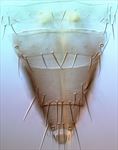Distinguishing features
Female macroptera. Body, legs and antennae light brown to brown; fore wings uniformly pale brown. Antennae 9-segmented, segment I with long toothed process; sensoria on III–IV small and incomplete; IX slightly longer than VIII. Head with ocellar setae III long, arising just within ocellar triangle. Pronotum with many microtrichia, with 10 pairs of discal setae, anteromedian pair longest; posterior angles with 2 pairs of long setae. Mesonotum with moderately long lateral setae, no microtrichia on anterior sculpture lines. Metanotum with concentric lines at anterior bearing microtrichia. Fore wing setae about as long as distance between veins. Fore tibial apex with one stout and one weaker ventro-lateral setae. Abdominal tergites I–VIII with weak sculpture lines medially, many microtrichia laterally; tergite VIII median marginal setae about as long as tergite; dorsal setae on IX–X slender. Sternite II with 2 pairs of posteromarginal setae, III–VI with 4 pairs; median sternites with about 12 discal setae, sternite VII with discal setae laterally but not medially.
Male smaller than female, tergite I with pair of longitudinal ridges; sternal setae long and dark.
Related species
Twelve species are currently described in the genus Cranothrips, 11 from Australia and one from South Africa (Pereyra & Mound, 2009). C. emersoni is particularly similar to C. ravidus, but is much smaller with the pronotal anteromarginal setae shorter.
Biological data
Breeding in the flowers of Thriptomene sp. [Myrtaceae], and presumably pupating at soil level.
Distribution data
Australia (southeast Queensland)
Family name
MELANTHRIPIDAE
Species name
Cranothrips emersoni Girault
Original name and synonyms
Cranothrips emersoni Girault, 1929: 1
References
Mound LA & Marullo R (1998) Biology and identification of Aeolothripidae (Thysanoptera) in Australia. Invertebrate Taxonomy 12: 929–950.
Pereyra V & Mound LA (2009) Phylogenetic relationships within the genus Cranothrips (Thysanoptera, Melanthripidae) with consideration of host associations and disjunct distributions within the family. Systematic Entomology 34: 151–161.


